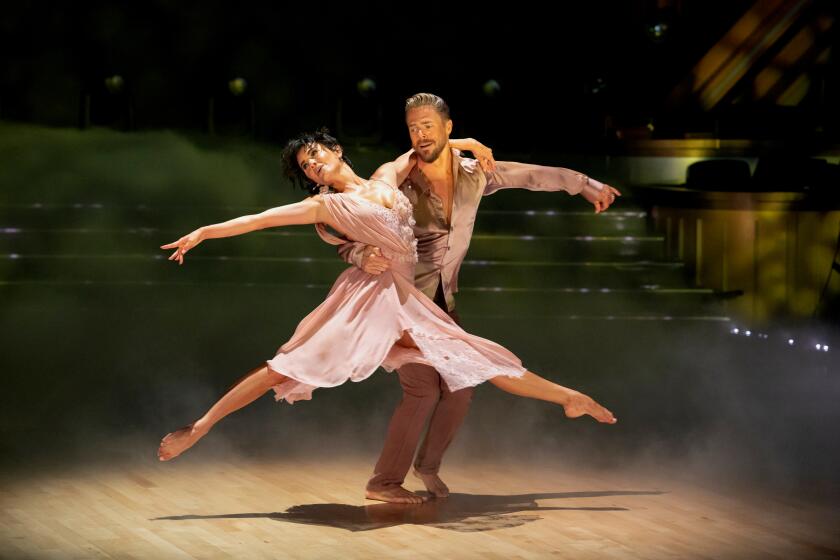Uplifted Orchestra, Uplifting Mahler
It was a topsy-turvy summer for the Los Angeles Philharmonic: A week before the solstice, managing director Willem Wijnbergen suddenly resigned; a week after the end of an unsettled summer, Deborah Borda was hired. Forget Wijnbergen, we are told. Now the orchestra has turned a corner, has a new spring in its step. Just listen.
Thursday night at the Dorothy Chandler Pavilion one could just listen as Esa-Pekka Salonen began his eighth season as music director of the Philharmonic. It was a splendid evening of Mahler. And the orchestra did, in fact, sound like a new band--fresh, alert, present. And for that, thank . . . Wijnbergen.
One innovation the controversial, short-lived managing director did accomplish was to enliven an acoustically dull concert hall for the new season. The stage has been raised a foot and moved 16 feet forward, altering the sight lines for some seats upstairs (a similar experiment was tried twice and canceled because of subscriber protest). It obviously wonât entirely please the Philharmonic bean-counters, since there are additional costs each week of installing and removing the extension, as well as the loss of revenue from the four rows of seats removed in front. And from the orchestra seats, where I was sitting, it does feel a bit awkward to look up to the musicians on stage. But it sounded, at last, as if we were sitting in the same room as the musicians, as if we were sharing the music with them, not eavesdropping.
The results are not perfect, but they do seem a bargain, considering what a full acoustic renovation would cost. The First Symphony of Mahler opens with a wondrous sound--a high harmonic whistle in all the strings, underpinned by a very subtle low A (the rest of the hourlong symphony could be considered a filling in of the middle of this eerie sonic frame). Those high harmonics on Thursday were like a mysterious shining energy force, and you could actually recognize the low pitch. Better still, you actually could feel the bass drum later.
Mahler was a good choice for the occasion. He provides a glorious sonic test, and he is a timely composer, more valuable for the questions he asks than for providing sure answers. Beethoven and Bach are the great classical composers of certain, assured, optimistic music. Mozart, Schubert and Mahler see a less secure world.
These are days when orchestras everywhere, and particularly the Los Angeles Philharmonic, are grappling with what their role should and could be in a new century. Mahler is modern and nostalgic. He can open new vistas with such ecstatic zeal that even Michael Eisner went out and commissioned new symphonies in Disneyâs name recently after hearing Mahlerâs Eighth. Yet Mahler can so persuasively share his personal despair that a listener is ready for wrist-slitting. The peace that Mahler achieves after his epic struggles transcends world-weariness with profound consolation.
All those qualities were on hand Thursday. The five orchestral songs to poems by Friedrich Ruckert sung by Jose Van Dam in the first half contain some of the saddest music I know. Mahler enters into the darkest place of the insecure soul in âAt Midnightâ and then bids heart-rending farewell to turmoil in âI Am Lost to the World.â The Belgian baritone, a singer of magisterial elegance, sang these with almost inhumanly calm restraint. Salonen conducted with cool precision. Baritone and maestro did ask for tears (when Bernstein was in charge of these songs there would rarely be a dry face in the crowd), but their stoicism had its own overwhelming poignancy.
The First Symphony is a youthful work, and after the intermission, Salonen gave it a youthful performance. He is as interested in how the symphony sounds as in what it says. So it was an evening for the orchestra to shine, appropriate as a season opening. The playing had liveliness and buoyancy and brilliance. Salonen illuminates the music but--and maybe this is a Finnish thing--not so much through brightness as definition of specific colors and rhythms. He has grown as a Mahler interpreter, and he has become increasing impressive in his ability to find a tight line from beginning to end, an anchor from which he can dramatically cut loose.
The concert began with the irresistibly lyric short movement âBlumine,â which Mahler wrote for an early version of the symphony when it had an elaborate program about a heroâs life. The stage was decked with flowers, and that is the same image that was on Mahlerâs mind. It provided a warm welcome for a new season in which we will see very little of Salonen, who has only three weeks with the orchestra before he begins a year sabbatical.
* The Los Angeles Philharmonic repeats its Mahler program Sunday at 2:30 p.m., $15-$70, 135 N. Grand Ave. (213) 365-3500.
More to Read
The biggest entertainment stories
Get our big stories about Hollywood, film, television, music, arts, culture and more right in your inbox as soon as they publish.
You may occasionally receive promotional content from the Los Angeles Times.











